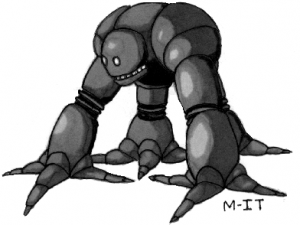 I’ve been thinking about using an expanded version of Stress Points in a third edition of The Artifact, let me explain why and maybe you can use a similar system in your own homebrew or houserule system.
I’ve been thinking about using an expanded version of Stress Points in a third edition of The Artifact, let me explain why and maybe you can use a similar system in your own homebrew or houserule system.
In a survival situation, you have a certain amount of energy and ability. The environment can sap you of that energy and ability over time. The faster that happens, the more dangerous that environment is. Nearly everyone knows this, but it isn’t handled in most games because it’s difficult to simulate without the right model. I think most game designers would like players to simply narrate this kind of situation and have it be really interesting but as I noted in my original Survival Games post, that almost universally doesn’t work.
A Stress Point is one way to simulate that sapping action. My thought is to have three groups of points Physical Stress, Functional Stress and Mental Stress. The reason for the different categories are so that the points can play off each other. That heavy parka may be able to soak 5 Physical Stress a day from cold but because of its heaviness it gives the character 1 Functional Stress and the hood blocks peripheral vision so it gives 1 Mental Stress. The player must now decide if their character should go with a lighter coat, take the Physical Stress and avoid the other stressors. Wow! Stats on how a parka can work and why we don’t all walk around wearing them all the time in the winter. That’s some progress.
How a Stress Point works is different from a Hit Point. Stress accumulates, so at a relaxed and comfortable state, a character has zero (0) stress. This has the handy side effect that when a GM doesn’t want to use Stress Points in a game, there is no book keeping for them. If you don’t need them, they can go away and let the rest of the game go by.
When they are in use, they degrade a character’s abilities. Here’s where the rate that players get stress points has to be adjusted for each individual game. For The Artifact, the numbers are very granular so they can be thrown around relatively easily. Even still, I might not want to give a character a full stress point all the time, and this even more true in a game that has very low (1-5) values for attributes. The solution that I came up with was to roll a die, say a 1d10, with each roll representing a chance that the character could get a Stress Point.
So say I skip my Parka for a wool trench coat. The coat has a soak of 2 Physical Stress, but because of its length is could cause some Functional Stress by getting caught in the door of a car, or on branches, etc. It isn’t a high chance so I’d say, on a roll of 1d10 if the roll is under a 2, the character gets a point.
This works for more than jackets though. One of the perennial arguments about armor is when the player says that they’re sleeping in their armor, or sleeping in their vehicle. Armor provides protection from damage but heavy armor is taxing to wear. Sure that bomb suit protects you more than the flack jacket, but it also gives you 2 Physical Stress 3 Functional Stress and 1 Mental Stress for each hour you wear it. Now you know why you don’t want to wear it everywhere. Your character will collapse after a while from the strain of wearing it.
Using three different categories of points allows for trade offs between points, making solutions that soak large amounts of points to have downsides. This makes survival equipment a matter of strategy instead of “I’ll take one of everything.” A full hiking backpack now adds 1 Physical Stress point per hour (I haven’t playtested these numbers, I’m just guessing). Instead of encumbrance, each add on creates an additional tax on the character but has a practical benefit that the character may get more out of. One character may be able to take huge amounts of Physical Stress while another can take high Functional Stress based on their attributes. Each one is going to build their equipment list based on their own needs.
Is there anything you would add or change in this execution?


 The Free RPG Blog
The Free RPG Blog